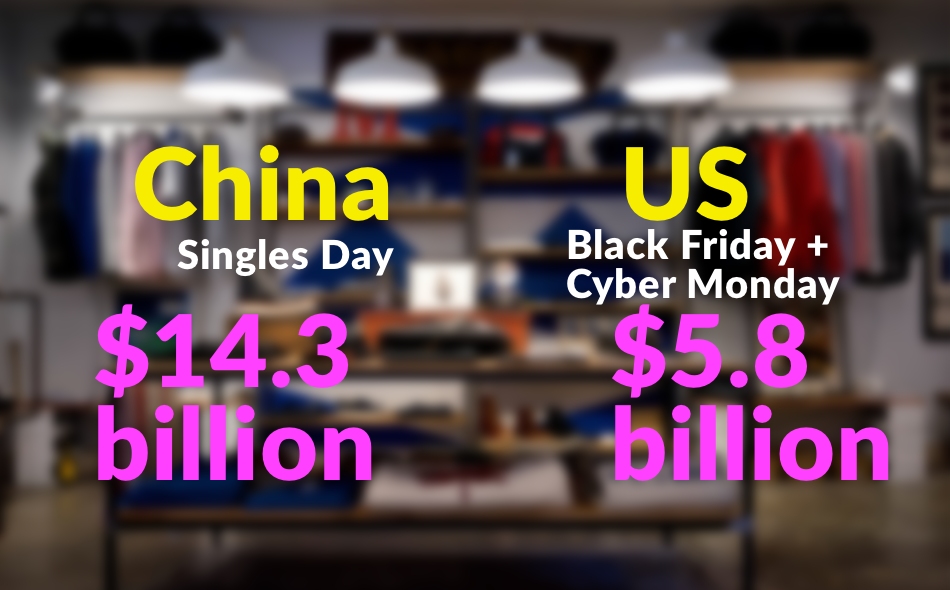Invented in the early 1990’s, China’s Singles’ Day is a very recent addition to the holiday calendar – but one that’s really caught on with Chinese consumers. Helped by aggressive marketing of the obscure ‘anti-Valentine’s’ holiday by China’s huge online retailer Alibaba, in 2014 Singles’ Day became the world’s largest online retail event. This year Chinese consumers spent £6bn online over the 24 hours of Singles’ Day.
China’s celebration of bachelorhood isn’t the only huge annual commercial event. The world marks a number of occasions with massive spending splurges – and with consumers increasingly spending their money online, it’s ecommerce that’s most elastic to these seasonal trends.
Perhaps the most famous – but no longer the largest, thanks to China’s singletons – is the ‘Black Friday’ shopping event. This started a few decades ago as a US holiday stretching over the weekend after the US holiday of Thanksgiving, which now culminates in ‘Cyber monday’. This first Monday after Thanksgiving is the biggest day for online purchasing in the mature ecommerce market of the US. The whole weekend event now reaches other markets outside the States, with raised ecommerce activity in places including Canada, Brazil, and Singapore as well as the UK during this period.
But Black Friday is old news. With consumers in big emerging markets such as India, China and Brazil embracing online shopping, a range of other cultural festivals are turning into major ecommerce events.
 In China and other markets such as Korea and Vietnam that mark the lunar calendar, New Year is a big event. Commercial activities tend to shut down over the holiday period, so it’s all about the advance sales. Chinese New Year can fall anytime between 20 January and 20 February and tends to be quite an extended season. Like the drawn-out holiday season in the US, Chinese New Year sees several weeks of changed patterns in consumer spending rather than a single day or weekend.
In China and other markets such as Korea and Vietnam that mark the lunar calendar, New Year is a big event. Commercial activities tend to shut down over the holiday period, so it’s all about the advance sales. Chinese New Year can fall anytime between 20 January and 20 February and tends to be quite an extended season. Like the drawn-out holiday season in the US, Chinese New Year sees several weeks of changed patterns in consumer spending rather than a single day or weekend.
It’s the growing middle classes, fairly new to ecommerce and the internet in general, driving a lot of these new online seasonal booms. India’s expanding ecommerce market means the festival of Diwali sees increasing online spend each year. A survey by PayPal found that three quarters of Indian consumers were intending to shop online during the Diwali season. As the Indian middle classes emerge as a serious consumer base online, that’s potentially a huge seasonal market.
In Japan online spending often sees a summer lift. Many Japanese employees receive bonuses and these are awarded during the summer period. It’s common to see a rise in spending on luxury goods and leisure activities, including travel. Purchases such as these are increasingly happening in an online environment.
Over in Russia, there’s a rise in household expenditure at the end of summer, as the annual start of the school year is marked as a major occasion. Sending a child back to school properly equipped is often a major financial undertaking and some businesses will even offer loans specifically for this occasion.
In Brazil, you can expect to see a bump in spending around mid-June as the country celebrates Día dos Namorados (Lovers’ day). There are similar days dedicated to romance worldwide but the dates often vary across the world. Taiwan even celebrates two: one in February and one in July.
Wow, those numbers about sales. I never heard of that day but it sounds definitely more interesting than valentines day, which is too overrated in my opinion. I find your thoughts very interesting.
ReplyDelete